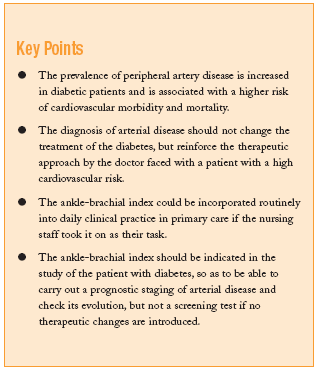Both symptomatic and sub-clinical peripheral artery disease causes a large decrease in functional capacity and quality of life, leads to limb amputations and increases the risk of death. These patients most probably have other ischaemic cardiac diseases, such as myocardial infarction or stroke. It is, in fact, a marker of atherothrombotic disease in other vascular regions.
In patients with diabetes, the presence of arterial disease is increased. It is particularly localised in distal zones (femoral, popliteal, and tibial area), unlike other risk factors such as smoking and hypertension, associated with disease in the aorta-iliac-femoral vessels. Owing to this localisation of the disease and its association with neuropathy, which reduces the sensitivity of the lower limbs, patients with diabetes are diagnosed later with peripheral artery disease. By the time the symptoms appear they have a higher risk of amputation and other fatal cardiovascular diseases.
The study by Bundó et al characterises the vascular risk of the diabetic patient with symptomatic or asymptomatic peripheral artery disease very well. It is a study carried out in Spain in a primary care setting, with a follow-up of 6 years on patients with diabetes and peripheral artery disease, in which it demonstrated the increased prevalence of clinical and sub-clinical disease, which goes from 6.9% to 21.4% on measuring the ankle-brachial index (ABI), on all known diabetics in their health centre. The follow-up of these patients showed an increase in the morbidity/mortality to be seen and a higher probability of microvascular and macrovascular complications of diabetes: ischaemic heart disease, stroke, cardiac failure, neuropathy and retinopathy as well as skin ulcers. An increase in nephropathy was not found, perhaps because this association required a larger number of cases in the study. Finally, the incorporation of this technique into daily clinical practice is recommended.
The ABI is a non-invasive, quantitative and reliable diagnostic method, as well as a prognostic predictor of peripheral artery disease. It is validated in relation with the diagnostic reference, angiography, with a sensitivity of 95% and a specificity of almost 100% for a cut off point of abnormality of <0.91. This method also has limitations, on giving false negative results in some symptomatic patients with moderate aorta-iliac stenosis and in people who have calcified, difficult to compress arteries, as happens in older people and in some patients with diabetes.
The American Diabetes Association recommends measuring the ABI in patients >50 years old with diabetes and a repeat test every 5 years if it is normal, with the purpose of obtaining an early sub-clinical diagnosis and to begin applying preventive measures which may prevent an amputation.1,2 However, according to the PAPPS (Preventive Activities and Health Promotion Program) recommendations (adaptation of the European Cardiovascular Prevention Guide) a few changes should be made, as regards aggressive therapy and special care of the feet, whether the patient with diabetes, may have arterial disease or not.3 We should remember that the guide places non-insulin dependent diabetes and insulin dependent diabetes with microalbuminuria in the high cardiovascular risk group, with treatment recommendations similar to established peripheral artery disease. The general impression is that these recommendations are sub-optimal and that the diagnosis of artery disease reinforces a more aggressive attitude by the doctor. In the SMART study, screening of asymptomatic cardiovascular disease is carried out with non-invasive imaging techniques in patients classified as high or low risk according to the European Cardiovascular Prevention Guide. In this, an ABI<0.90 was only found in 5 patients out the 545 initially classified as low risk. In other words, only 0.91% of the low risk patients were reclassified to high risk by the sub-clinical diagnosis of artery disease.4
The measurement of ABI in primary care is feasible. The technique takes 10-15 minutes to perform, but to be used routinely it would be necessary for the nursing staff to assume this task. The ABI enables a diagnosis of artery disease to be made, to establish the baseline value and to make a prognostic staging of the disease. Its follow-up enables us to understand the evolution of the disease and it is a prognostic factor of cardiovascular mortality (Bundó et al). In any case, it is difficult to recommend it as a screening test, since the diagnosis of artery disease should not change the therapeutic approach, unless diabetes with arterial disease in future investigations is classified as very high risk and may change the treatment objectives or different treatments may be used for this diabetic group. To insist that the doctor complies with the recommendations of the guides, it would be more logical to introduce this test as a screen now. Future lines of investigation is the presence of an abnormal ABI in patients with impaired fasting glucose or glucose intolerance.5 These have lower vascular risk and an abnormal ABI could lead to a change in the therapeutic approach. Another possible line is the prognostic significance of a high ABI, since in some studies it has also been associated with an increase in cardiovascular mortality.6








